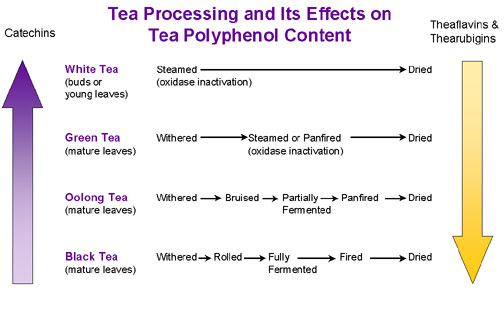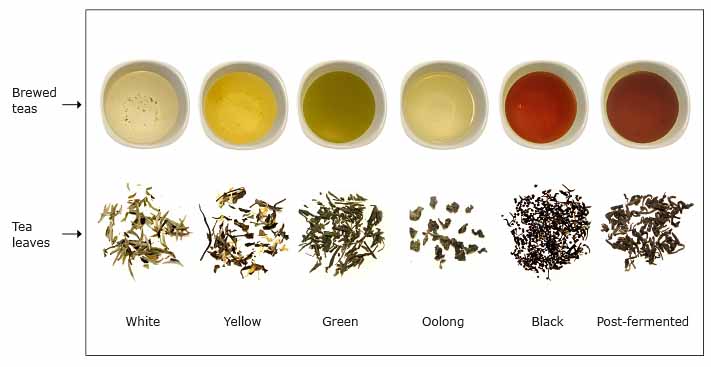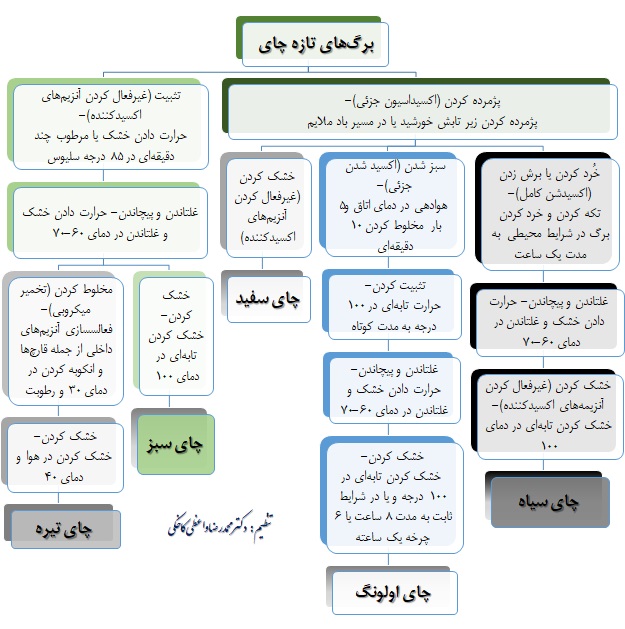انواع گوناگون چای را به شیوه های زیر تهیه میکنند:
https://examine.com/supplements/tea-camellia-sinensis/
.
.
Table of Contents:
۱Contents of Camellia Sinensis
Plants derived from Camellia Sinensis (Green, Black, White, and Oolong Tea) contain:
- Green Tea catechins
- Bioflavonoids such as Myricetin, Quercetin and Kaempferol as various glycosides[1][2]
- L-Theanine
- Polyphenolic compounds beyond Green Tea Catechins (Ellagic Acid, Gallic Acid)
- Pyrroloquinoline quinone[3][4]
- GABA
- Caffeine and other xanthines such as theophylline, usually at 10-20mg/g of leaves[5]
- A platelet inhibiting compound called ‘L2’[6] with the structure of 2-amino-5-(N-ethylcarboxyamido)-pentanoic acid[7][8]
- Terpene compounds (Geraniol, Nerol, α-terpinolene, nerolidol, etc.)[9]
۲Processing of types of Camellia Sinensis

۲٫۱٫ White Tea
White tea is unique in the fact that it is processed from unopened buds, classified as silver needles (bai hao Yinzhen), or an unopened bud with two leaves covered in white leaf hairs.[10] Afterwards, they are sometimes dried or withered by the air to remove moisture content; this leaves them with a curled silvery appearance.
It tends to be known as the most relaxing tea of the list, as it has highest levels of GABA,[11] Pu-erh tea has the lowest as GABA is lost during fermentation.
۲٫۲٫ Oolong Tea
Oolong tea tends to, like white tea, be partially oxidized.
As they still have active enzymes, some of the catechin content is polymerized into theaflavins and thearubigins.
۲٫۳٫ Green Tea
Green Tea leaves tend to be non-oxidized.
۲٫۴٫ Black Tea
Black tea leaves tend to be fully oxidized.
۲٫۵٫ Pu-erh (Fermented) Tea: Dark Tea
After initial picking, Pu-erh tea leaves are turned into raw Pu-erh by a process called ‘kill green’ and then fermented by microorganisms for 6-12 months.[2] Some of the more high quality Pu-erh teas are fermented for greater than a decade.[12]
Pu-erh tea has a taste that is described as ‘complex, silky smooth, and mellow’ but develops a sensory experience similar to green tea after being aged, but perhaps slightly more bitter.[2]
When tea is fermented by bacteria, levels of catechins initially drop.[2] However, new compounds are generated via microorganisms, such as theabrownin[13] and statins, which is produced by the Streptomyces cinereus strain Y11 bacteria.[12][14]
Overall, green tea is the ‘basic’ tea that is enzymatically inactive and non-oxidized. White tea and Oolong tea are partially oxidized, but Oolong is still enzymatically active. Black tea is fully oxidized and enzymatically active. Pu-erh tea is fermented and quite unique from the other teas.
۳Preparation of Tea for Home Consumption
In studies looking at the interactions between milk and tea catechins (ie. adding milk to your tea) the milk can form protein-catechin complexes with the tea catechins which negate the anti-oxidant potential (by sequestering hydroxyl groups).[15] This, however, is not likely to result in a reduced bioavailability.[16] Although the protein-catechin complex is metabolically inactive, it is digested and free catechins are released in the intestines.[16] Bioavailability studies looking at all tea catechins note no differences in overall serum levels of free catechins (green and black tea) when milk is added at a 1:5 ratio of milk:tea,[17] although a partitioning effect has been observed, with less EGCG and ECG being absorbed yet more EC and EGC.[18]
One study noted that milk ingestion with green tea abolished the catechins’ beneficial effects on cardiovascular health (vasorelaxation),[19] but has been criticized for its methodology as it took a single measurement 2 hours after ingestion when the benefits associated with green tea could be chronic in nature.
Consumption of tea with milk may alter but does not significantly reduce the bioavailability of green tea catechins; it has been suggested that proteins may abolish the benefits of green tea catechins on heart health, but the lone study supporting this notion has some methodological flaws
۴Comparison of Tea types
Green Tea Catechin content varies depending on species:
- White tea tends to be in the range of 14.40 to 369.60 mg/g of dry plant material[20]
- Green tea tends to be in the range of 21.38 to 228.20 mg/g of dry plant material[20]
In comparing different sources of Camellia Sinensis:
- White tea appears to have more catechins overall by weight, but when the catechin content is even green tea has a higher anti-oxidant potential[20]
- When fermented, tea tends to lose antioxidative potential; however, some measures of anti-inflammatory status increase (as measured by macrophage NO release via LPS)[21]
- Green tea appears to be the least effective at inhibiting the ACE enzyme in blood pressure regulation, with green < oolong < white < black < dark teas.[22]
Scientific Support & Reference Citations
References
- Composition of Polyphenols in Fresh Tea Leaves and Associations of Their Oxygen-Radical-Absorbing Capacity with Antiproliferative Actions in Fibroblast Cells.
- Zhang L, et al. Comparison of the chemical constituents of aged pu-erh tea, ripened pu-erh tea, and other teas using HPLC-DAD-ESI-MSn. J Agric Food Chem. (2011)
- Nutritional biochemistry: A new redox-cofactor vitamin for mammals.
- Protective Effects of Green Tea Extract against Hepatic Tissue Injury in Streptozotocin-Induced Diabetic Rats.
- Khokhar S, Magnusdottir SG. Total phenol, catechin, and caffeine contents of teas commonly consumed in the United kingdom. J Agric Food Chem. (2002)
- Ali M, Afzal M. A potent inhibitor of thrombin stimulated platelet thromboxane formation from unprocessed tea. Prostaglandins Leukot Med. (1987)
- Ali M, et al. A potent thromboxane formation inhibitor in green tea leaves. Prostaglandins Leukot Essent Fatty Acids. (1990)
- Afzal M, et al. 2-Amino-5-(N-ethylcarboxamido)-pentanoic Acid from Green Tea Leaves. Planta Med. (1987)
- Lee S, et al. Effect of supercritical carbon dioxide decaffeination on volatile components of green teas. J Food Sci. (2007)
- White and Green Teas (Camellia sinensis var. sinensis): Variation in Phenolic, Methylxanthine, and Antioxidant Profiles.
- Zhao M, et al. Determination and comparison of γ-aminobutyric acid (GABA) content in pu-erh and other types of Chinese tea. J Agric Food Chem. (2011)
- Jeng KC, et al. Effect of microbial fermentation on content of statin, GABA, and polyphenols in Pu-Erh tea. J Agric Food Chem. (2007)
- Wang Q, Peng C, Gong J. Effects of enzymatic action on the formation of theabrownin during solid state fermentation of Pu-erh tea. J Sci Food Agric. (2011)
- Yang DJ, Hwang LS. Study on the conversion of three natural statins from lactone forms to their corresponding hydroxy acid forms and their determination in Pu-Erh tea. J Chromatogr A. (2006)
- Arts MJ, et al. Interactions between flavonoids and proteins: effect on the total antioxidant capacity. J Agric Food Chem. (2002)
- van der Burg-Koorevaar MC, Miret S, Duchateau GS. Effect of milk and brewing method on black tea catechin bioaccessibility. J Agric Food Chem. (2011)
- van het Hof KH, et al. Bioavailability of catechins from tea: the effect of milk. Eur J Clin Nutr. (1998)
- Egert S, et al. Simultaneous ingestion of dietary proteins reduces the bioavailability of galloylated catechins from green tea in humans. Eur J Nutr. (2012)
- Lorenz M, et al. Addition of milk prevents vascular protective effects of tea. Eur Heart J. (2007)
- Unachukwu UJ, et al. White and green teas (Camellia sinensis var. sinensis): variation in phenolic, methylxanthine, and antioxidant profiles. J Food Sci. (2010)
- Xu Y, et al. Variations of Antioxidant Properties and NO Scavenging Abilities during Fermentation of Tea. Int J Mol Sci. (2011)
- Dong J, et al. Inhibition of angiotensin converting enzyme (ACE) activity by polyphenols from tea (Camellia sinensis) and links to processing method. Food Funct. (2011)



